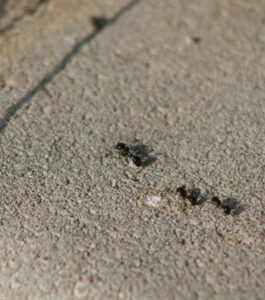Pest Management Solutions for Your Business
Ants seem like an innocent pest. What harm could a few ants in the parking lot of a food processing plant or assisted living facility present? A lot more than you think.
Similar to other crawling insects such as cockroaches, ants can carry bacterial and disease-causing organisms that can contaminate food, food preparation surfaces and lead to food-borne diseases, including E. Coli and salmonella. Their presence in commercial properties where food is prepared, stored or served will certainly catch the eye of third-party auditors and inspectors.

Pavement ants forage on the surface outside a commercial property.
It is important for clients to remember that an effective ant management program is not an overnight process. Finding the right solution starts with a prevention strategy, positively identifying the ant species involved and locating the root cause of the infestation.
An Ant Attraction
Warmer weather and spring rains bring an increase in ant pressure around commercial properties. According to Paul Harriot, A.C.E., branch manager for Sprague in Portland, Oregon, foraging members of ant colonies are seeking protein sources and will look inside commercial facilities to satisfy their need to feed.
“Commercial property managers can easily underestimate the threat ants present,” said Harriot. “While ants are primarily outdoor pests their aggressive foraging activity will lead them indoors in search of food.”
Harriot said ants, like all pests are brand destroyers when customers or employees witness them crawling across indoor surfaces. Sprague clients in the Pacific Northwest typically encounter pavement or odorous house ants, while clients in California, Nevada and Arizona are more likely to encounter Argentine and the occasional fire ant in addition to pavement and odorous house species.
“Ants will find their way into spaces where people work and visit – desks, front counters, food areas – and where clients don’t want them,” said Harriot. “Seeing a couple of ants is misleading since only a small percentage of a colony makes itself known. Those ants are part of a colony that can number in the thousands and that is much more than a nuisance.”
How Do Ants Get Inside
Ants typically establish nests next to sidewalks, parking lots and under pavement next to commercial structures. Harriot said ants will take advantage of expansion joints, unsealed utility penetrations, openings around HVAC units and gaps in roofing, and landscape and construction features including tree branches, electrical wires, gutters, etc. to gain access to a structure.
Once inside a commercial facility, ants will seek out food and moisture sources in kitchens, break rooms or in wall voids or under slabs near hot water pipers, in machinery compartments of food processing equipment and beneath leaky fixtures.
“Ants will follow the path of least resistance to gain access to a facility,” said Harriot. “And they are not only a threat at ground level. Soil nesting ants – like pavement ants – will climb trees or building features in pursuit of an opening to get inside.”
Harriot recalled an instance where Sprague took over service in a hotel that was experiencing high ant pressure in multiple rooms. The previous company had been performing perimeter treatments adjacent to the structure, but the ants persisted.
When conducting his initial inspection of the property Harriot noticed an electrical box by a dumpster at the end of the parking lot. A closer look revealed significant ant activity around the dumpster and box. The box fed electricity to the hotel through pipes beneath the parking lot and the ants were using the pipes to gain access to the hotel. A targeted application of ant bait around the box and dumpster was able to eliminate the root cause of the issue.
Ant Proofing Your Commercial Property
How do you prevent ants from becoming an issue and reduce the number of callbacks for these persistent pests? Focusing on exclusion and sanitation practices and modifying the physical environment in and around your facility is where effective ant management starts.
- Exclusion – Seal cracks in the foundation and slab floors, install door sweeps, repair screens, and caulk around door frames. Caulk around utility penetrations that lead into structures.
- Sanitation – Clean up food spillage and debris and deep clean food processing or storage equipment to make your interior spaces less attractive to these invasive social insects. Keep dumpsters away from entrances.
- Environmental modification: Your commercial property is not an island, and the nearby environment can impact pest pressure. Overgrown landscapes provide harborage and tree branches touching a building provide access points for ants. Eliminate moisture sources – leaky faucets, irrigation systems or standing water.
Discover The Sprague Difference
If you are looking for an innovative pest management service provider for your commercial property, connect with the Sprague pest management experts at 800.272.4988.

